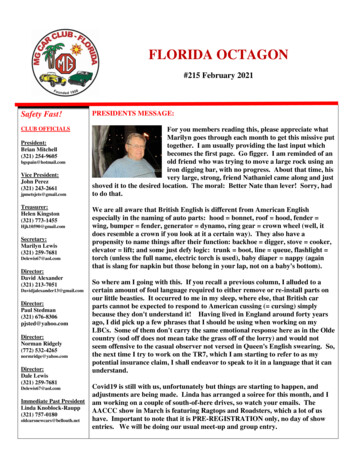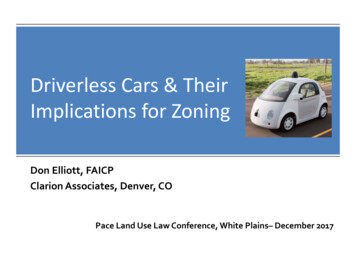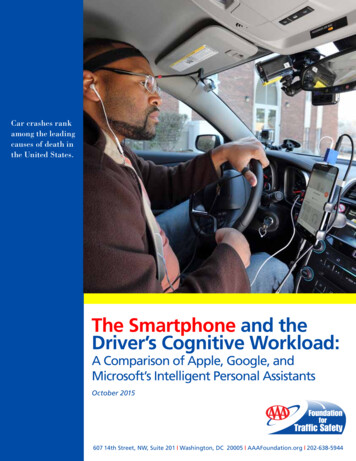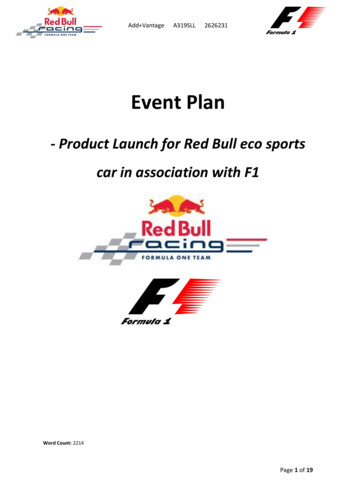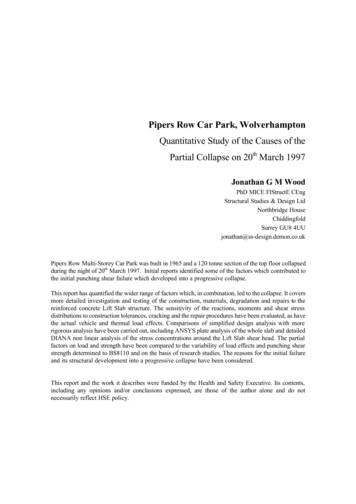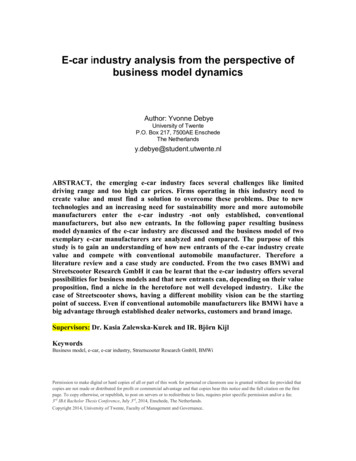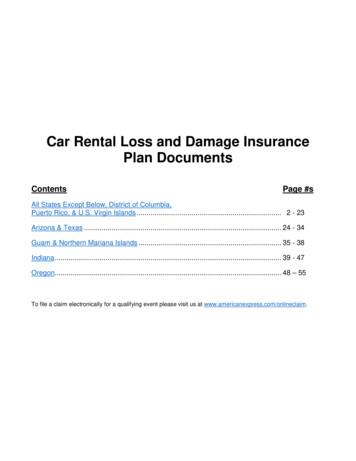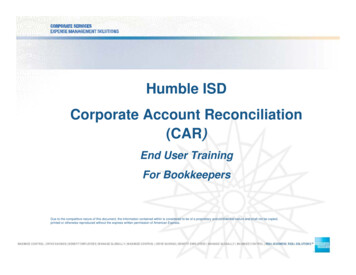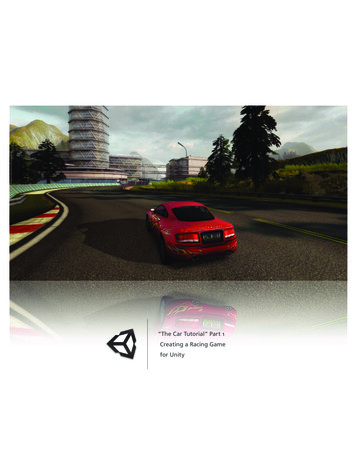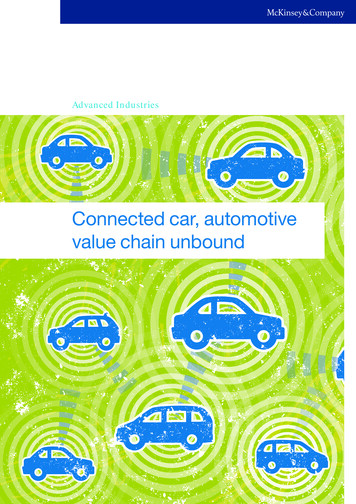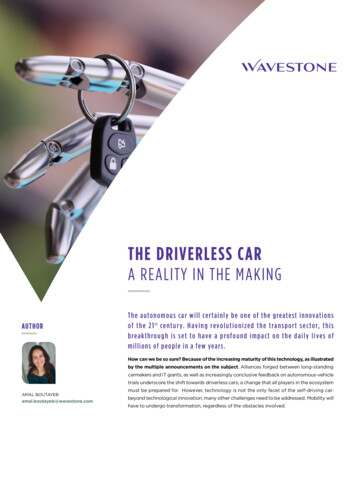
Transcription
THE DRIVERLESS CARA REALITY IN THE MAKINGAUTHORThe autonomous car will certainly be one of the greatest innovationso f t h e 2 1 s t ce n t u r y. H av i n g revo l u t i o n i ze d t h e t ra n s p o r t s e c to r, t h i sb re a k t h ro u g h i s s et to h ave a p ro fo u n d i m p a ct o n t h e d a i l y l i ve s o fmillions of people in a few years.How can we be so sure? Because of the increasing maturity of this technology, as illustratedby the multiple announcements on the subject. Alliances forged between long-standingcarmakers and IT giants, as well as increasingly conclusive feedback on autonomous-vehicletrials underscore the shift towards driverless cars; a change that all players in the ecosystemAMAL BOUTAYEBamal.boutayeb@wavestone.commust be prepared for. However, technology is not the only facet of the self-driving car:beyond technological innovation, many other challenges need to be addressed. Mobility willhave to undergo transformation, regardless of the obstacles involved.
AUTONO MO US TEC HN OLOGY:A L E V ER FO R MO BIL ITYTR A N S FO RMATIO NThe emergence of new technologies hasalready triggered a series of in-depthchanges in the transportation sector atseveral levels, ranging from passengerservices to operations and maintenance.This has also given rise to changes in theautomobile and road transport sectors.Given the mobile tools and applications onoffer, players employing disruptive strategiesare already strongly calling existing modelsLong-standing carmakers have also showna lot of interest in the autonomous car.Trends in automation, initiated severaldecades ago gave rise to functionalities,such as anti-lock breaking systems (ABS)The combination of innovative technologiesgeneral public. Automatic technologiesis therefore gradually paving the way for theare therefore already integrated, even in carautonomous vehicle. This trend is set to gaincontrol functions.momentum thanks to the hybrid nature ofIn addition, vehicles are becomingincreasingly connected with theoutside world, be it with other vehicles,infrastructures or platforms.Technological progress is being made atfor the emergence of numerous services.several levels:However, in addition to these new trends//which are already having an impact onsociety, technology is set to take roadtransport to another level. Vehicles arebecoming increasingly autonomous andimplemented and considerable progressmade in the field of connected, automatedand autonomous vehicles. Some mediatizedexamples include but are not limitedto, the Google and Tesla driverless cars.Automation and artificial intelligence:In addition to data analysis, robotizationcan be used to make vehicles actin accordance with the informationprocessed, a trend that is makingvehicles increasingly intelligent.that are now known to and used by theinto question and, as such, paving the wayconnected. Many initiatives have been////these cars in which the driver can still takeback control of the vehicle, on the motorwayand in traffic jams for example. On the otherhand, fully autonomous vehicle usage hasalready been tested and solutions rolledout, although these are generally limited tospecific stretches (short-distance shuttlesand low-density roads). The different levelsData: Data storage capacity andmultiple information sources (sensors,user information, etc.) exponentiallyenrich the reservoir of available data, aswell as that of geographical and trafficdata.Analysis capacity: With processessuch as data mining and predictivealgorithms, technology is making itpossible to go beyond simple datacollection thanks to computingpowerandstoragecapacity.2of autonomy, defined by the Society ofAutomotive Engineers (SAE), will give riseto several development models. Despitetheir differences, these models are notmutually exclusive and will be developedsimultaneously to offer greater autonomousmobility.
THE DRIVERLESS CAR: A REALITY IN THE MAKINGA movement now underway!201120132014ASSESSMENT OF CITYMOBIL 1European R&D autonomoustransport projectNISSAN TEST IN JAPANAutonomous vehiclemotorway testFrench launch ofPROJET SCOOP@F201720162015RATP, STIF and the city of Paris testAUTONOMOUS INTER-STATION SHUTTLERENAULT-NISSAN/MICROSOFT ALLIANCEGOOGLE CIRCULATES FIRST PROTOTYPEof its autonomous car on public roadsFrench launch ofAUTOPILOT PROJECTIBM files patentFOR A COGNITIVE SYSTEMenabling switch between driving andautonomous modesIBM/ INTEL/MOBILEYE ALLIANCEto test 40 AV modelsMERCEDES/NVIDIA ALLIANCEAV launchFCA/GOOGLE ALLIANCETesla launches its Master Plan Part 2Mercedes unveils its Van of the future forLAST MILE MANAGMENTUBER to launch 4-AV FLEETTELSA launches itsAUTOMATIC PILOTIMPLEMENTATION OF M-CITYA 13-HECTARE ARTIFICAL MOCK CITYdesigned to test autonomous vehiclesLaunch of the HONGQI HQ3 car in AsiaProduct of research carried out by the Universityof Defense and the FaW group.201820202021PSAto proposeautonomous vehiclesRENAULT-NISSANto launch autonomous vehiclesFORDannouncesMASS AV PRODUCTIONTOYOTAto test its autonomous carAT THE TOKYO OLYMPIC GAMESAUDI / NVIDIA ALLIANCEto launch its autonomous car20602035According to the University ofSanford, BETWEEN70 - 90% OF TAXIS WILL BEAUTONOMOUSGOOGLEexpects AVs to represent9% OF THE GLOBAL FLEET32025ASIAN CARMAKER CHANG’ANpresent itsto present entire AV fleet
ALLIANCES, PARTENRSHIPS, ACQUISITIONS, AND RECRUITMENT.ENCOUNTERS THAT REVEAL FUTURE TECHNOLOGICAL CHALLENGESPRECI SE 3D M A PPI N GS E NSORS , PE RC E PTION AND ADVANC E DDE TEC TION SYSTE MSTh e BM W, A u d i a nd D a i m l e r Co n so r t i u m a cq uiret h e H E RE car to g ra p hy a nd nav ig at iona l sof twa re p l at fo rm( n ow k now n a s H E R E We G o) i n Aug ust 2 01 5Vo l kswa ge n a n d Mo bi l eye fo rg e p a rt n ers h i p to i m p l e me ntn ew o p t i ca l s en s o r system sSYST EM SECU RI TYINTEGRATE D PLATFORMSIn A p r i l 2 017, t h e Zo ox st a r t- u p a n n o u n ce d t h e a p p o i ntme ntof M ar k Ro s elin e , for m e r Dire ctor of t he N H TSA ( N at io n a lH i g hway Tra f f i c S a fety Ad m i ni st rat i on) a sC hi e f S a fe ty In n ovat i o n O f f i ce rN v i di a a n d I ntern et g i a nt B a a i du j o i n fo rces tos et u p « cl o ud-to -ca r » AV p l at fo rmN E E DS BECO MING C RIT IC ALby taking into account the emergence ofBy 2050, it is estimated that 70% of thein transport services. The following pointspopulation will be living in urban areashighlight several autonomous vehicleand that there will be 27 megacities eachopportunities:with a population of between 10 and 20million people. As such, current transportnew car-ownership models and the increase//models will not suffice to ensure mobilitytransformation. This will require advancesin areas such as traffic management, roadsafety and security, car-park capacity andthe environmental footprint. Transport isthe biggest generator of CO² emissionsin France and the car the major sourceof emissions per km per capita. Althoughautonomous mobility is not the onlydevelopment axis, it is an opportunity tobenefit from new technologies to changevehicle usage trends. How? In several ways;to urban and peripheral traffic flows,optimizing truck traffic managementby grouping vehicles into platoonscould reduce truck fuel consumptionby 25% and therefore the levelofgreenhousegasemissions.The «European Truck PlatooningChallenge» has been launchedin Europe to test this traffic-flowsolution.//Higher vehicle occupancy rates,which will reduce the amount ofprivate vehicles on the roads.Occupation rates of cars could be aparameter that is taken into accountin mobility services and even aregulatory obligation for transportservices.More efficient traffic management.Adjusting automobile itineraries tomeet traffic constraints and postingdrivers’ points of departure anddestinations could optimize thenumber of vehicles in circulation, andhelp avoid bottlenecks. In addition4//Better car park management withthe possibility of parking vehiclesin dedicated car parks that are notnecessarily in close proximity to thedriver’s destination.Although needs are the same in thetraditional and autonomous mobilitysegments, driverless cars immediatelyevoke obstacles that could prevent us fromenvisaging a future without drivers.
THE DRIVERLESS CAR: A REALITY IN THE MAKINGthe connected car and the autonomousOBSTAC LES S HO ULD T RIG G E RACTI ONterms of road safety and security. The ideaAny changes, especially major, couldis therefore not to limit the exercise toNew technologies tend to be expensiveremove obstacles facing the playersdetecting the vehicle’s initial risk potentialbefore reaching the mass marketingconcerned; whether they are involved inbut rather to examine the solutions availablestage. However, given expected changesthe change or the targets impacted by thisand address cyber risk upstream by thinkingin traditional car buying and ownershipchange.Cyber Security “By Design”.models, vehicle transport could becomeThese obstacles must not hamper reflectionand idea generation. They must not bemasked, but rather anticipated. In order tobest prepare for this change, it is essentialto remember the values targeted. Examplesillustrating this stance are three-fold:1Car hacking and road safety. Newtechnologies can be vulnerable: thesurface of IT vulnerability (attack surface)in cars is increasing and driving functionscan even be exposed to tampering. In 2016,the team of researchers of the Chinesecompany, Keen Security demonstratedthat these weak points can be exploited bymalicious hackers. Clearly, hijacking vehiclescan cause serious accidents. However,vehicle offer numerous opportunities in3High-tech AV inaccessibility versusnew cheaper innovation modelsless expensive over time and open to new2Job loss versus labor-marketsegments of the population. For instance,momentumseamless mobility solutions could be offeredA 2014 study carried out by Stanfordto persons with reduced mobility.University shows that autonomous carsThe stance to be adopted here, therefore,could account for between 70% and 90% ofis to consider the driverless car as antaxis on the roads by 2060. At first glance,opportunity to create value. This doesthe advent of the self-driving car suggestsnot mean ignoring the negative impactsjob loss. On the contrary, this trend will giveof autonomous vehicles, or users’rise to the emergence of new professionsapprehensions; both of these factors shouldin different fields, such as production,be taken into account in a forward-lookingmaintenance and new services. There isstrategy. An innovative approach must fix itstherefore an increasing need to anticipateobjectives and the value targeted in order tothese new professions both at the corporateset the stage for reflection and debate, andlevel, to pave the way for the upcomingto anticipate and address risks upstream sochanges, and in the field of education, toas to reassure stakeholders.ensure that graduates and job seekers alikeThe diagram on page 6 gives a non-exclusiveare qualified.list of some of the aims of the driverless car.5
Expectations regarding autonomous vehiclesE M PLOYM EN TROAD SAFE TY & S EC URI TYVa lue c reati o n s h o u l d b e a na lyze d f rom t he p oi nt of v iew o fjo b c reati o n : t ren ds i n p rofe ssi ona l ca re e r p at hs a re set toc h an g e an d tr i gger t he e m e rg e nce of new p rofe ssions.Au to n o m o u s m o b i l i ty i s a m a j o r fa cto r u n d erp i n n ing thered u ct i o n i n ri s ks . C l ea r exa m p l es o f t h i s i n cl u d e o ptimizings p eed m a n a g em ent a n d avo i d i n g d ri vi n g wi t h b l o o d alcoholl evel s t h at a re over t h e l eg a l l i m i t .T RAI NI N G A N DRE S E ARCHE N V I RON N EM E N TS u ch a st ru ctural changewi l l b e u n d erpinne d byt h e m o me ntuma n d ch a n ge in thetea ch i ng andres ea rch a pproache sp u tt i n g i t at the fore fronto f t h i s d o main withm u l t i p l e facets anda p p l i cations.Co mb i n e an d stream l i netran s p o r t t h an k s toe co l o g i cal co r n ersto n e ssuch as s m ar t u s ag e,veh i c l e i ti n erar yop t i m i z ati o n an dspeed m an agem ent , etc.ECO N O M YNE W US E R-S E RVI C E STh e i m p l em ent at i on of new se r v ice s a ndindu str i es , as wel l as op e n d at a w i ll i nj e ct a new e conom i cdy n am i c u n der pi n n e d by new a ll ia nce s forg e d b etwe e nl o n g- stan d i n g m ar ket p l aye rs a nd young st a r t-up s.I n crea s e o f a wi d e ra n g e o f AV a p p l i cat i o n s s uch asm o b i l i ty a s a s ervi ce, ca r s h a ri n g , s i m p l i f i ed l o g istics anda cces s i b i l i ty fo r p eo p l e wi t h red u ced m o b i lity.6
THE DRIVERLESS CAR: A REALITY IN THE MAKINGREGULATO RY FRAM E WORK MU STGRA DUALLY ADAPT TO STAYABR E AST O F PRO GRE S SDepartment of Motor Vehicles authorizedHowever, the widespread use of self-driving27 California-based companies to testcars will come about gradually, later on inself-driving vehicles on the roads.the 21st century. But why the delay? BecauseThe authorities are currently monitoringIn addition to the initiatives taken byautonomous mobility in order to paveautomobile manufacturers, IT playersthe way, and prepare society for thisand research institutes, etc., work groupsin-depth innovation. To do this, however,and public authorities have implementedthe framework will have to be adaptedthe regulatory measures needed to meetto address future mobility trends atexpected security and legal liabilityall levels. These include responsibilityrequirements. In Europe, the United Nationsissues, road safety and security, technicalEconomic Commission for Europe (UNECE)standardization, interoperability, economicreviewed the Convention of Vienna in 2016policy, job market trends, as well as societalfor the purposes of authorizing autonomoussupport with future structural changes.car traffic flows.To stay abreast of technological progress,regulations will be progressively adapted forthe
THE DRIVERLESS CAR: A REALITY IN THE MAKING 1 3 2. 6 Expectations regarding autonomous vehicles EMPLOYMENT ROAD SAFETY & SECURITY TRAINING AND RESEARCH ENVIRONNEMENT Value creation should be analyzed from the point of view of job creation: trends in professional career paths are set to change and trigger the emergence of new professions.
